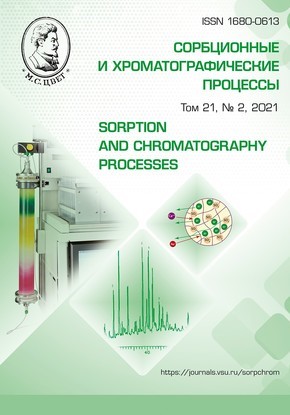The kinetics of sorption of lithium cationby freshly precipitated aluminium hydroxide from natural brine
Abstract
For over twenty years of the 21st century, the consumption of lithium compounds in terms of lithium carbonate, used as a standard market commodity, has tripled, and the price has increased from $ 2 to $ 8 per kilogram. More than 35% of lithium compounds are used in the production of batteries and chemical power sources, about 32% in the production of ceramics and glass. With an increase in demand for lithium products, the raw material base has fundamentally changed; now, about 70% of lithium compounds are extracted from hydromineral raw materials. Lithium carbonate is obtained from strong sodium chloride type brines from the American continent using the halurgic technology. In China, from magnesium and calcium chloride type brines with a high lithium content and a total mineralization of more than 400 g/dm3, lithium is extracted using a granular sorbent developed by ZAO Ecostar-Nautech (Novosibirsk, Russia).
This study is devoted to the investigation of the kinetics of sorption of Li+ by freshly precipitated aluminium hydroxide from a natural lithium-containing sodium chloride calcium type brine with a mineralization of about 70 g/dm3.
The kinetic curves of Li+ adsorption on Al (OH)3 at different temperatures were processed by the equations of diffusion and chemical kinetics. The processing of experimental data using the calculated kinetic diagrams for mixed diffusion revealed the prevalence of external diffusion in the mixed diffusion mechanism at 293 K, and at 303 K and 313 K internal diffusion prevailed.
The experimental data were also processed according to the pseudo-first and pseudo-second order equations used for the description of chemical kinetics. A comparison of the results showed that at 293 K the value of the calculated sorption value provides a better agreement with the experimental value when using the pseudo-first order model with practically the same correlation coefficients of R2 for both models. At temperatures of 303 and 313 K, the sorption value was in better agreement with the experimental value when using the pseudo-second order model. The chemical kinetics of this process in the temperature ranges of 293-303 K and 303-313 K was evidenced by the activation energies of 94 and 46 kJ/mol, respectively.
Downloads
References
Kotsupalo N.P., Ryabtsev A.D., Boldyrev V.V., Nauka v Rossii, 2011, No 5, pp. 28-31.
Kudryavtsev P.G., Al'ternativnaya ener-getika i ekologiya (ISJAEE), 2016, No 13-14, pp. 72-88.
Kotsupalo N.P., Ryabtsev A.D. Kkimiya i tekhnologiya polucheniya soedineniy litiya iz litienosnogo gidromineral'nogo sy-r'ya. ZAO «Ekostar-Nautekh». Novosi-birsk. Akadem. izd-vo «Geo». 2008. 291 p.
Flexer V., Baspineiro C.F., Claudia Inés Galli C.I., Science of the Total Environment, 2018., Vol. 639, pp. 1188-1204.
Saenko E.V., Leont'eva G.V., Vol'khin V.V., Kolyshkin A.S., Zhurnal neorgani-cheskoy khimii, 2007, Vol. 52, No 8, pp. 1399-1404.
Chitrakar R., Kanoh H., Makita Y., Miyai Y. et al., J. Mater. Chem., 2000, Vol. 10, pp. 2325-2329.
Chitrakar R., Kasaishi S., Umeno A., Sakane K. et al., J. Solid State Chem., 2002, Vol. 169, pp. 35-43.
Ohashi F., Tai Y., Materials Letters, 2019, Vol. 251, pp. 214-217.
Ventura S., Bhamidi S., Hornbostel M., Proceedings, 43rd Workshop on Geothermal Reservoir Engineering Stanford University, Stanford, California, February 12-14, 2018, SGP-TR-213, pp. 1-5.
Song, J.F., Nghiem L.D., Li X.-M., He T., Environmental Science: Water Re-search & Technology, 2017, Vol. 3(4), pp. 593-597.
Ryabtsev A.D. i dr. Patent RF. No 2455063, RU. 2012.
Kompleksnaya pererabotka poli-komponentnykh litienosnykh rassolov s predvaritel'nym ikh obogashcheniem po liti-yu, Pod red. N.P. Kotsupalo; ZAO «Eko-star-Nautekh». Novosibirsk. Akadem. izd-vo «Geo». 2014, 172 p.
Kotsupalo N.P., Ryabtsev A.D. In-terkalyatsionnye soedineniya gidroksida al-yuminiya s solyami litiya i ikh ispol'zo-vanie v promyshlennoy praktike. OOO «Ekostar-Nautekh». Novosibirsk. Akadem. izd-vo «Geo».. 2016. 155 p.
Jiang H., Yang Y., Sun S., Yu J., J. Chem. Eng., 2020, Vol. 98, pp. 544-555.
Ramazanov A.SH. et al., Patent RF, No 2660864 S2, 2018.
Ramazanov A.Sh., Khimiya i tekhnologiya vody, 1991, Vol. 13, No 2, pp. 140-143.
Ramazanov A.Sh., Kasparova M.A., Saraeva I.V., Alkhasov A.B. et al., Ekologiya i promyshlennost' Rossii, 2016, Vol. 20, No 2, pp. 14-17.
Gel'ferikh F. Ionity, M., Izd-vo in-ostr. lit., 1962, 490 p.
Boyd G.E., Adamson A.W., Myers L.S., J. Am. Chem. Soc., 1947, Vol. 69, pp. 2836-2848.
Venitsianov E.V. Rubinshteyn R.N. Dinamika sorbtsii iz zhidkikh sred, M., Nau-ka, 1983, 237 p.
Dresvyannikov A.F., Petrova E.V., TSyganova M.A., Zhurn. fiz. khimii., 2010, Vol. 84, pp. 727-732.
Mathew A.P., Weber W.J., Chem. Eng. Commun., 1984, Vol. 25, pp. 157-171.
Alosmanov R.M., Vestn. Mosk. Un-ta. Ser.2.Khimiya, 2011, Vol. 52, No 2, pp. 145-148.
Ho Y., Water Res., 2006, Vol. 40, pp. 119-125.
Rudzinski W., Plazinski W., J. Phys. Chem. C, 2007, Vol. 111, pp. 15100-15110.
KHamizov R.Kh., Sveshnikova D.A., Kucherova A.E., Sinyaeva L.A., Zhurn. fiz. Khimii, 2018, Vol. 92, pp.1451-1460







